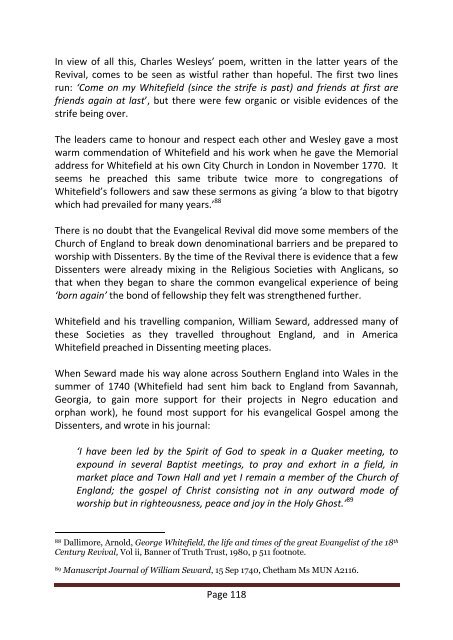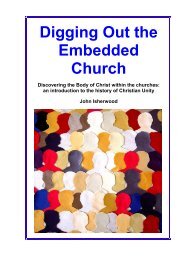Christian Unity (the book) - The Maranatha Community
Christian Unity (the book) - The Maranatha Community
Christian Unity (the book) - The Maranatha Community
You also want an ePaper? Increase the reach of your titles
YUMPU automatically turns print PDFs into web optimized ePapers that Google loves.
In view of all this, Charles Wesleys’ poem, written in <strong>the</strong> latter years of <strong>the</strong>Revival, comes to be seen as wistful ra<strong>the</strong>r than hopeful. <strong>The</strong> first two linesrun: ‘Come on my Whitefield (since <strong>the</strong> strife is past) and friends at first arefriends again at last’, but <strong>the</strong>re were few organic or visible evidences of <strong>the</strong>strife being over.<strong>The</strong> leaders came to honour and respect each o<strong>the</strong>r and Wesley gave a mostwarm commendation of Whitefield and his work when he gave <strong>the</strong> Memorialaddress for Whitefield at his own City Church in London in November 1770. Itseems he preached this same tribute twice more to congregations ofWhitefield’s followers and saw <strong>the</strong>se sermons as giving ‘a blow to that bigotrywhich had prevailed for many years.’ 88<strong>The</strong>re is no doubt that <strong>the</strong> Evangelical Revival did move some members of <strong>the</strong>Church of England to break down denominational barriers and be prepared toworship with Dissenters. By <strong>the</strong> time of <strong>the</strong> Revival <strong>the</strong>re is evidence that a fewDissenters were already mixing in <strong>the</strong> Religious Societies with Anglicans, sothat when <strong>the</strong>y began to share <strong>the</strong> common evangelical experience of being‘born again’ <strong>the</strong> bond of fellowship <strong>the</strong>y felt was streng<strong>the</strong>ned fur<strong>the</strong>r.Whitefield and his travelling companion, William Seward, addressed many of<strong>the</strong>se Societies as <strong>the</strong>y travelled throughout England, and in AmericaWhitefield preached in Dissenting meeting places.When Seward made his way alone across Sou<strong>the</strong>rn England into Wales in <strong>the</strong>summer of 1740 (Whitefield had sent him back to England from Savannah,Georgia, to gain more support for <strong>the</strong>ir projects in Negro education andorphan work), he found most support for his evangelical Gospel among <strong>the</strong>Dissenters, and wrote in his journal:‘I have been led by <strong>the</strong> Spirit of God to speak in a Quaker meeting, toexpound in several Baptist meetings, to pray and exhort in a field, inmarket place and Town Hall and yet I remain a member of <strong>the</strong> Church ofEngland; <strong>the</strong> gospel of Christ consisting not in any outward mode ofworship but in righteousness, peace and joy in <strong>the</strong> Holy Ghost.’ 8988Dallimore, Arnold, George Whitefield, <strong>the</strong> life and times of <strong>the</strong> great Evangelist of <strong>the</strong> 18 thCentury Revival, Vol ii, Banner of Truth Trust, 1980, p 511 footnote.89Manuscript Journal of William Seward, 15 Sep 1740, Chetham Ms MUN A2116.Page 118








